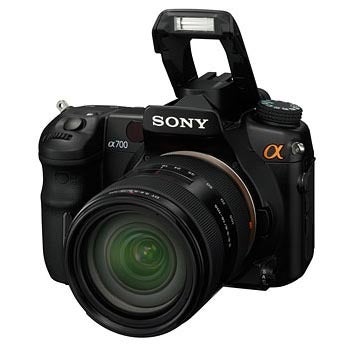The 10.2-megapixel Sony Alpha A200 replaces the two-year-old A100 with a number of subtle improvements including a larger LCD screen and increased sensitivity range.
Sony Alpha a200 Review
Performance and Handling
AF Performance
Whether the continuous autofocus mode is indeed 1.7x faster than the Sony Alpha A100 is something that would be difficult to measure precisely, but it certainly is fast. In good light, the camera has no problem locking onto subjects, and only slows down when moving rapidly from distant subjects to those close up. Predictably, lower light levels slow it down a touch, but it still remains fairly speedy.
Dust Control
Despite the anti-dust facility vibrating the sensor each time the camera is powered off, we did notice a few specks of dust on certain images. This isn’t a criticism of the anti-dust function per se, but we do question Sony’s logic of having the sensor vibrating on power-off rather than on start-up. The latter would make more sense, as it would ensure that you start off shooting with a dust-free sensor – especially if you have just changed lenses or if the camera has not been used for a period of time. The only reason I can think of as to why Sony has done this is so that it wouldn’t compromise start-up time (which, incidentally, is prompt), though we’d rather wait a touch longer for the camera to start up than risk dust and then need to post-process it out of images.
As promised, the noise coming from the mirror slapping up is a little quieter than that of the Sony Alpha A100, but it’s still a touch noisy. It is, however, a more direct, faster and less ‘lagging’ sound, and thus less intrusive.
General Handling
In the past we have enjoyed using the previous Sony Alpha A100 model, but always felt that there was room for improvement in terms of its general operation and the way that certain features were accessed. Clearly Sony thought the same, with the tweaks and refinements on the A200 serving to facilitate more convenient operation.
Control Layout
A new Function (Fn) button sits above the main menu pad, which allows a quick access to flash, metering, autofocus, AF area, white balance and D-Range Optimiser settings. On the Sony Alpha A100, these were accessed via a secondary mode dial on the top-plate, which now features the more traditional PASM and Scene options that were previously located on the side of the shutter release. Having to rotate the dial, press the dial’s central Fn button and then use the other hand to adjust shooting parameters seemed unnecessarily complex, so this change here is most definitely welcome.
You soon realise this has come at a cost, though. Repositioning the camera’s mode dial to the other side of the top-plate has allowed for a dedicated ISO button in its former place, joining the shooting mode button which was located here previously. The ISO button is hard to reach comfortably, using either finger or thumb, and the shooting mode button even more so, being positioned further away from the grip. Even when a strap isn’t in use, these two buttons aren’t exactly ‘to hand’ but rather just past it. Keeping the mode dial here would have made more sense, as its thumb and finger operation isn’t affected whether you’re using a strap or not.
Larger LCD Screen
The rear has seen a revised design to accommodate the larger Clear Photo 2.7in LCD screen, which has seen a marginal increase of 400 pixels to 230,400. Aside from this, the camera has adopted a less angular form, with the smooth and rounded contours making it feel a lot nicer in the hand. The remote socket has also been repositioned from the back to the side, and the Super SteadyShot button now lies horizontally, underneath the menu pad.
Ease of Operation
As on the Sony Alpha A100, the front command dial is recessed into the grip fairly deeply (but even more so here), and as such makes turning it a little more difficult than it could be. Also, I don’t have the largest of hands but I still found that the grip wasn’t quite large enough to offer enough purchase. At first the camera felt comfortable in my hand but after being out with it for a while, my forefinger felt squashed into the camera’s body – something I would imagine that people with either larger hands or longer nails would find even more annoying.
One downside of the Sony Alpha A100 was that the built-in flash had to be raised manually without the aid of any dedicated flash button. This had been carried over from the Dynax 5D model, and it’s unclear as to why this wasn’t initially addressed, but Sony has now provided a button to the side of the flash unit itself. In addition, the camera’s hotshoe accepts dedicated flashguns from Sony’s Alpha line as well as those from third-party manufacturers.
Dimensions and Weight
The camera has been marketed as smaller and lighter than its predecessor. To be pedantic, these changes are only within a few millimetres (with the A200 in actual fact being a little taller), and as such are barely noticeable. Granted, there’s also a 13g reduction in weight but all of these changes are so very slight and barely noticeable at best, and may have, dare I say, simply resulted as a byproduct of the camera’s manufacture.





